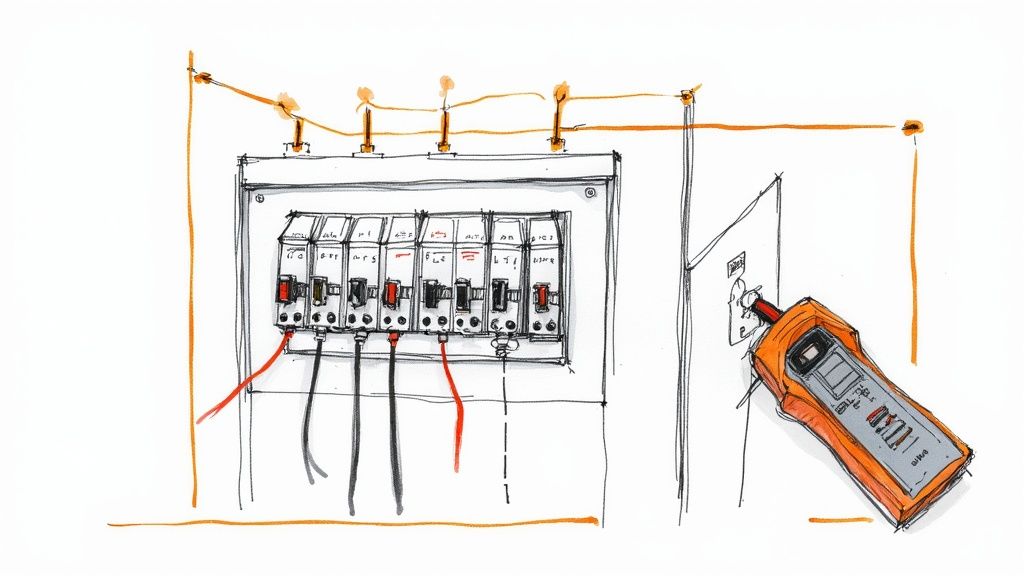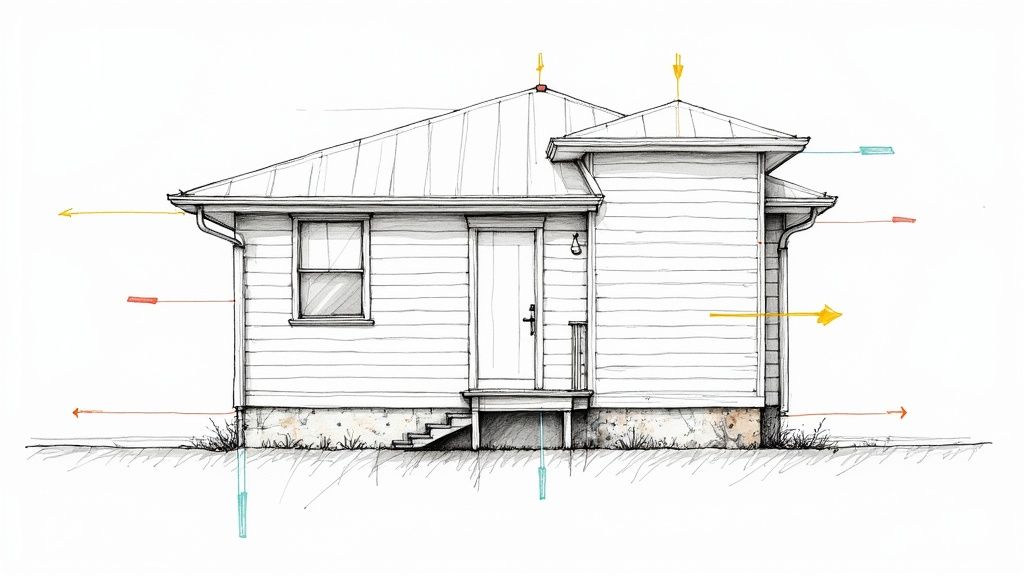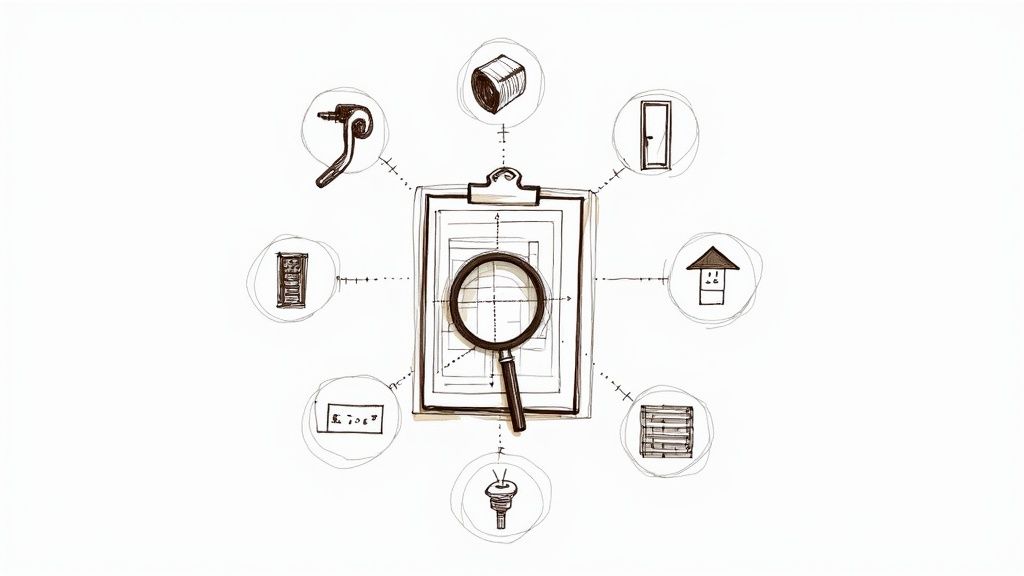A thorough rental inspection is more than just a quick walkthrough; it's your first line of defence against future disputes, costly repairs, and tenant dissatisfaction. In the competitive UK rental market, a detailed, documented inspection protects your investment and sets a professional standard from day one, fostering a transparent landlord-tenant relationship.
This guide moves beyond simply ticking boxes. It offers a comprehensive rental property inspection checklist that delves into the critical systems and conditions defining a safe, habitable, and well-maintained property. We will provide a systematic approach to evaluating everything from hidden plumbing issues to the structural integrity of the building itself.
Prepare to cover every crucial detail before a tenancy begins, during a periodic review, or at the end of a lease. For landlords, property managers, and even conscientious tenants, mastering this process is fundamental. This isn't just about compliance; it's about proactive and intelligent asset management that safeguards value and ensures peace of mind for everyone involved. Let's explore the eight non-negotiable inspection areas that form a truly bulletproof assessment.
1. Plumbing System Assessment
A meticulous plumbing system assessment is arguably one of the most critical components of any thorough rental property inspection checklist. This goes far beyond a quick glance; it involves a detailed evaluation of all fixtures, visible pipes, water pressure, and drainage systems. The primary goal is to catch minor issues before they escalate into catastrophic failures, which are often the most destructive and costly repairs a landlord can face.
Neglecting this check can lead to slow leaks causing structural rot, mould growth, and pest infestations, or sudden bursts that flood an entire property. For instance, spotting corroded flexible hoses under a kitchen sink during an inspection can prevent an inevitable burst, saving thousands in water damage repairs. Similarly, identifying a slow, silent leak from a toilet cistern can prevent long-term damage to the floorboards and ceiling below.
Key Inspection Actions
To perform a comprehensive plumbing check, follow these actionable steps:
- Test All Fixtures: Systematically run every tap (both hot and cold) and shower. Flush every toilet to check for proper function and refilling.
- Check Water Pressure: Note if the water pressure seems unusually low in any area. This could indicate a larger problem like mineral buildup or a hidden leak in the supply line.
- Inspect for Leaks and Damage: Look under all sinks, behind toilets, and around appliance connections for any signs of moisture, water stains, mould, or dampness.
- Assess Drainage: Ensure all sinks, baths, and showers drain quickly and without gurgling sounds, which can signal a potential blockage.
- Evaluate the Water Heater: Document the age, condition, and any visible signs of leakage or corrosion on the hot water cylinder or boiler. Note how long it takes for hot water to reach the furthest tap.
By dedicating proper attention to the plumbing system during a move-in, move-out, or periodic inspection, landlords and property managers can proactively manage maintenance, ensure tenant safety, and protect their valuable asset.
2. Electrical System Safety Check
A rigorous electrical system safety check is a non-negotiable part of any comprehensive rental property inspection checklist. This involves much more than simply flicking switches on and off; it requires a detailed review of all visible wiring, outlets, the consumer unit (fuse box), and overall safety compliance. The fundamental purpose is to identify and rectify potential fire and electrocution hazards, ensuring the property is safe for tenants and compliant with UK electrical safety standards.

Ignoring this crucial check can have devastating consequences. Faulty wiring is a leading cause of domestic fires, and outdated systems can pose a serious risk of electric shock. For example, an inspection might reveal that a 1970s-era property lacks modern RCD/GFCI protection, a critical safety feature. Discovering and rectifying overloaded circuits in a multi-unit building during an inspection can directly prevent a potential fire, protecting both lives and the property investment.
Key Inspection Actions
To conduct a thorough electrical safety check, focus on these actionable steps:
- Test Outlets and Switches: Check that every light switch functions correctly. Use a simple plug-in socket tester to verify that all outlets are properly wired and grounded.
- Inspect the Consumer Unit: Open the consumer unit to ensure all circuit breakers are clearly and accurately labelled. Look for any signs of overheating, such as discolouration or a burning smell.
- Check for RCD/GFCI Protection: Verify that circuits in high-risk areas like kitchens and bathrooms are protected by a Residual Current Device (RCD) or Ground Fault Circuit Interrupter (GFCI). Test these by pressing the "test" button to ensure they trip the circuit.
- Look for Visible Hazards: Scan for frayed or exposed wires, cracked or damaged outlets, and the improper use of extension leads as a form of permanent wiring.
- Verify Lighting Adequacy: Ensure all areas, including common hallways, basements, and lofts, have sufficient and functional lighting to prevent accidents.
By integrating a meticulous electrical system review into your move-in, move-out, and periodic inspections, you can ensure tenant safety, meet legal obligations, and safeguard your property from significant, preventable risks.
3. HVAC System Performance Evaluation
A comprehensive HVAC system performance evaluation is a non-negotiable part of any rental property inspection checklist. It involves a thorough check of the property's heating, ventilation, and air conditioning systems to ensure they operate efficiently and safely. This assessment is vital for maintaining tenant comfort, controlling energy costs, and preserving the longevity of expensive equipment.

Ignoring the HVAC system can lead to unexpected breakdowns, leaving tenants without heating in winter or cooling in summer, which can result in costly emergency repairs and tenant disputes. For example, discovering and replacing a clogged air filter during a routine inspection can prevent strain on the system, improve air quality, and lower utility bills. Similarly, identifying and sealing ductwork leaks in an attic or crawl space can dramatically improve efficiency, as one landlord found when it reduced a property's monthly heating costs by over £150.
Key Inspection Actions
To conduct a detailed HVAC evaluation, focus on these actionable steps:
- Test Both Modes: Regardless of the season, test both the heating and cooling functions to ensure the system can switch and operate correctly.
- Check Air Filters: Inspect the condition of all air filters. Note the date they were last changed and establish a clear replacement schedule, which is crucial for efficiency.
- Inspect Vents and Registers: Confirm that air is flowing freely from all vents and registers. Check that none are blocked by furniture or debris.
- Listen for Unusual Noises: Turn the system on and listen for any strange noises like rattling, grinding, or loud humming, which could indicate a mechanical issue.
- Verify Thermostat Function: Test the thermostat to ensure it accurately reads the temperature and correctly signals the HVAC unit to turn on and off.
By including a detailed HVAC check in your rental property inspection checklist, you can proactively manage maintenance, ensure regulatory compliance, and provide a comfortable living environment for your tenants.
4. Structural Integrity Assessment
A robust structural integrity assessment is a non-negotiable part of a professional rental property inspection checklist. This is a deep dive into the building's core framework, evaluating everything from the foundation and walls to the roof and floors. The core objective is to uncover any signs of stress, degradation, or damage that could compromise tenant safety, affect habitability, and lead to astronomical repair costs down the line.

Overlooking structural issues can have severe consequences, far beyond aesthetic concerns. For instance, discovering significant settling in a 50-year-old property’s foundation through diagonal wall cracks can prompt essential underpinning work, preventing catastrophic failure. Similarly, identifying damaged roof trusses from heavy snow or ice dams can avert a potential roof collapse, safeguarding both the occupants and the asset itself.
Key Inspection Actions
To conduct a thorough structural assessment, concentrate on these key areas:
- Look for Wall Cracks: Meticulously inspect interior and exterior walls, paying close attention to cracks extending from the corners of doors and windows. Note their size, direction, and whether they appear to be growing.
- Check Floors, Ceilings, and Roofline: Sight down ceilings and floors for any noticeable sagging or unevenness. From outside, check the roofline for any dips or bows, which can indicate problems with the underlying structure.
- Inspect the Foundation: Examine the visible foundation for significant cracks, signs of bowing, or evidence of water intrusion and damp. This is the bedrock of the property's health.
- Test Railings and Stairs: Firmly test all handrails, banisters, and staircases to ensure they are stable, secure, and meet safety standards.
- Document Past Modifications: Make a note of any walls that may have been removed or altered. Illegally modified load-bearing walls are a major safety hazard.
By methodically evaluating the property's structural health during each inspection, landlords and property managers can identify and address foundational risks, ensuring the long-term safety and value of their investment.
5. Safety and Security Systems Review
A comprehensive review of all safety and security systems is a non-negotiable part of any professional rental property inspection checklist. This step involves a meticulous examination of all devices designed to protect tenants and the property itself, from fire safety equipment to security alarms. The core objective is to ensure full compliance with legal safety standards and to provide tenants with a secure living environment, which in turn protects the landlord's investment.
Overlooking this crucial check can have severe consequences, including hefty fines for non-compliance, invalidated insurance claims, and most importantly, endangering tenant lives. For instance, discovering a single expired fire extinguisher during an inspection can prevent a major code violation during a city safety audit. Similarly, confirming that hardwired smoke detectors have a functional battery backup can be a life-saving measure during a power cut.
Key Inspection Actions
To perform a thorough safety and security check, follow these actionable steps:
- Test All Detectors: Physically test every smoke alarm and carbon monoxide detector using the 'test' button. Document their locations and expiry dates, as most units need replacing every 10 years.
- Inspect Fire Safety Equipment: Check that fire extinguishers are present, properly mounted, fully charged, and not expired. If the property has a fire blanket, ensure it is accessible and in good condition.
- Verify Emergency Exits: Confirm all designated emergency exits, including windows in bedrooms, are unobstructed and fully operational. Ensure they are clearly marked where required by local regulations.
- Assess Security Systems: If an alarm system is installed, test its functionality, including all sensors and the backup battery. Check locks on all doors and windows to ensure they are secure and functioning correctly.
- Document Everything: Keep a detailed log of all safety equipment, including model numbers, installation dates, and maintenance records. This documentation is vital for demonstrating due diligence.
By systematically evaluating all safety and security measures during move-in, move-out, and periodic inspections, landlords can ensure they meet their legal obligations, enhance tenant wellbeing, and safeguard their property against preventable risks.
6. Interior Condition and Habitability Check
A detailed evaluation of the property's interior condition and overall habitability is a cornerstone of a comprehensive rental property inspection checklist. This step moves beyond major systems to focus on the aesthetic and functional quality of the living spaces themselves, including walls, floors, ceilings, and fixtures. The primary objective is to ensure the property meets legal habitability standards and is presented in a condition that attracts and retains high-quality tenants.
Overlooking this check can lead to tenant disputes over pre-existing damage, faster property degradation, and longer vacancy periods. For example, by proactively repainting and professionally cleaning the carpets between tenants in a townhouse rental, a landlord could justify a higher rent, potentially increasing it by over £100 per month. Similarly, refinishing worn hardwood floors in a vintage flat not only improves its appeal but also protects the underlying structure and attracts a more discerning tenant pool.
Key Inspection Actions
To conduct a thorough interior condition and habitability assessment, follow these actionable steps:
- Examine Walls, Ceilings, and Floors: Inspect all surfaces for damage like holes, scuffs, water stains, or peeling paint. Note the condition of flooring, checking for worn carpets, scratched wood, or cracked tiles.
- Test Doors and Windows: Open and close every interior and exterior door and window. Confirm they operate smoothly, latch securely, and that all locks are fully functional.
- Assess Fixtures and Fittings: Check the condition and operation of light fixtures, ceiling fans, blinds, and curtain rods. Ensure all are clean, safe, and working as intended.
- Evaluate Storage Spaces: Inspect built-in wardrobes, cupboards, and other storage areas for cleanliness, structural integrity, and proper door function.
- Document All Pre-existing Damage: Use high-resolution photos and detailed notes to create a clear record of the property's condition before a tenant moves in. This is vital for fair deposit deductions later.
By meticulously documenting the interior's state, landlords and property managers can establish a clear baseline, manage tenant expectations, and make informed decisions about cost-effective refurbishments that enhance the property's value and appeal.
7. Exterior and Grounds Maintenance Evaluation
A comprehensive evaluation of the property's exterior and grounds is a vital part of any rental property inspection checklist, safeguarding the building's structural integrity and enhancing its curb appeal. This process involves a detailed review of all external elements, from the roof down to the landscaping. The primary objective is to identify maintenance needs, prevent weather-related damage, and ensure the property remains safe, attractive, and compliant with local standards.
Neglecting the exterior can lead to significant long-term problems, such as water ingress from clogged gutters causing foundation damage, or overgrown trees posing a risk to the roof during a storm. For example, installing proper drainage around a single-family home can prevent chronic basement flooding, saving tens of thousands in remediation costs. Similarly, maintaining a clean and well-kept exterior, perhaps through pressure washing or fresh paint, has been shown to dramatically increase rental enquiries and attract higher-quality tenants.
Key Inspection Actions
To conduct a thorough exterior and grounds check, incorporate these actionable steps into your process:
- Assess Siding and Roofing: Visually inspect the siding for cracks, rot, or damage. Check the roof for missing or slipped tiles and examine gutters and downpipes for blockages or leaks, especially after major storms.
- Evaluate Landscaping and Fencing: Examine the condition of lawns, garden beds, trees, and hedges. Ensure all fencing and gates are secure and in good repair.
- Check Walkways and Paving: Inspect all paths, driveways, and patios for trip hazards like uneven slabs, cracks, or moss growth. Ensure any outdoor lighting is functional for safety.
- Verify Proper Drainage: Confirm that the ground slopes away from the building's foundation to prevent water pooling and potential damp issues.
- Inspect Outdoor Amenities: Check the condition and safety of any decks, sheds, or play equipment included with the property. For tougher cleaning jobs, you can learn more about how to remove stubborn stains.
By systematically reviewing the exterior and grounds during each inspection, landlords and property managers can proactively manage maintenance, enhance the property's value, and ensure a safe and pleasant environment for tenants.
8. Appliances and Built-in Systems Functionality Test
A thorough operational assessment of all appliances and built-in systems is a non-negotiable part of a comprehensive rental property inspection checklist. This check verifies that every piece of equipment provided with the property, from the cooker to smart home devices, is functioning correctly and safely. It's about ensuring the tenant receives a property in the condition advertised and preventing immediate maintenance calls upon move-in.
Skipping this crucial step can lead to significant inconvenience for tenants and potential liabilities for landlords. For example, identifying a faulty refrigerator compressor during an inspection prevents a new tenant from losing hundreds of pounds worth of food. Similarly, discovering a jammed garbage disposal unit before handover allows for a simple repair, avoiding a more complex plumbing issue later. Ensuring a smart thermostat's software is updated can also prevent connectivity problems for a tech-savvy tenant.
Key Inspection Actions
To conduct a detailed functionality test on all appliances and systems, follow these actionable steps:
- Run Full Appliance Cycles: Don’t just turn them on and off. Run a full wash cycle on the dishwasher and washing machine to check for leaks, strange noises, or incomplete cycles.
- Test Cooking Equipment: Systematically test every hob, grill, and oven function. Check that the oven reaches and maintains the correct temperature, and ensure extractor fans and lights are working.
- Verify Refrigeration: Place a thermometer inside the refrigerator and freezer to confirm they are holding a consistent, safe temperature for food storage.
- Check Ventilation and Safety: Ensure all ventilation for gas appliances is clear and unobstructed. Test that carbon monoxide and smoke alarms are powered and functioning correctly.
- Document All Details: Record the make, model, and serial numbers of all appliances. Noting their general age and condition helps in planning for future replacements and managing any warranty claims.
8-Point Rental Inspection Checklist Comparison
| Inspection Type | Implementation Complexity 🔄 | Resource Requirements ⚡ | Expected Outcomes 📊 | Ideal Use Cases 💡 | Key Advantages ⭐ |
|---|---|---|---|---|---|
| Plumbing System Assessment | Moderate – may need professional plumber | Medium – tools for pressure & leak detection | Detect leaks, ensure water flow, prevent damage | Pre-rental turnover, annual maintenance | Prevents water damage, tenant safety, reduces liability |
| Electrical System Safety Check | High – requires licensed electrician | High – specialized tools & expertise | Fire hazard prevention, code compliance | Older buildings, every 3-5 years | Enhances safety, reduces liability, improves energy efficiency |
| HVAC System Performance Evaluation | Moderate to High – professional recommended | Medium to High – testing equipment | Improve comfort, reduce energy costs, prevent breakdowns | Seasonal check, tenant comfort assurance | Energy savings, equipment longevity, better air quality |
| Structural Integrity Assessment | High – may need structural engineer | High – detailed inspections & possibly testing | Identify structural hazards, safety assurance | Aging properties, suspected damage | Maintains property value, ensures safety, prevents major failures |
| Safety and Security Systems Review | Moderate – regular battery and system checks | Medium – testing devices & monitoring systems | Tenant protection, code compliance | Multi-unit rentals, safety compliance checks | Reduces liability, deters crime, peace of mind |
| Interior Condition and Habitability Check | Low to Moderate – visual and functional tests | Low to Medium – basic tools & documentation | Tenant satisfaction, marketability, repair planning | Tenant turnover, pre-listing inspections | Attracts quality tenants, reduces complaints, shortens vacancy |
| Exterior and Grounds Maintenance | Moderate – seasonal and weather-dependent | Medium – inspections and some contractor involvement | Prevent weather damage, enhance curb appeal | Annual maintenance, seasonal preparation | Enhances property value, prevents damage, attracts tenants |
| Appliances and Built-in Systems Test | Moderate – operational testing of multiple systems | Medium – testing appliances & mechanical systems | Functional amenities, safety & energy efficiency | Move-in inspection, routine maintenance | Reduces emergencies, tenant satisfaction, warranty management |
Final Thoughts: Turning Your Checklist into an Asset
Navigating a rental property inspection can feel like a simple administrative task, but as we've detailed, it's a foundational process for successful property management. This isn't just about ticking boxes; it's about transforming a routine procedure into a powerful asset that protects your investment, fosters positive landlord-tenant relationships, and minimises future disputes. A meticulously completed rental property inspection checklist is the cornerstone of a transparent and professional tenancy agreement.
By systematically evaluating everything from the plumbing and electrical systems to the structural integrity and grounds maintenance, you create an indisputable record of the property's condition at the start of a tenancy. This detailed baseline is your greatest ally, providing clarity and preventing the common "he said, she said" arguments that can arise over security deposits and end-of-tenancy charges. It sets clear, manageable expectations for tenants regarding their responsibilities and demonstrates your commitment as a diligent, organised landlord or property manager.
Key Takeaways for Proactive Property Management
Remember, the true value of this checklist extends far beyond a single move-in or move-out event. It is a strategic tool for proactive maintenance and asset preservation.
- Documentation is Your Defence: A comprehensive, signed report with photographic or video evidence is your most robust tool for fairly resolving deposit disputes and justifying any necessary deductions.
- Proactive Maintenance Saves Money: Identifying minor issues like a dripping tap, a faulty electrical socket, or a small crack in a windowpane during an inspection prevents them from escalating into costly, emergency repairs down the line.
- Building Trust is Essential: A thorough inspection process demonstrates professionalism and care. When tenants see you are invested in maintaining a safe and habitable home, it builds a foundation of respect and encourages them to take better care of the property.
Ultimately, mastering the art of the property inspection is about shifting your perspective from reactive problem-solving to proactive asset management. It's about recognising that the time invested in a detailed walkthrough and a comprehensive rental property inspection checklist pays dividends in reduced vacancies, lower maintenance costs, and a more stable rental income. You are not just checking on a house; you are safeguarding the long-term value and performance of a significant financial asset. By embracing this diligent approach, you ensure your property remains a source of pride and profitability for years to come.
To ensure your property inspection starts from the highest possible standard, a professional pre-tenancy clean is invaluable. Signal Cleaning specialises in meticulous end-of-tenancy and deep cleaning services that establish a perfect baseline for your inventory, helping you meet and exceed tenant expectations from day one. Visit Signal Cleaning to see how they can help you prepare your property for a smooth and successful tenancy.

Leave a Reply